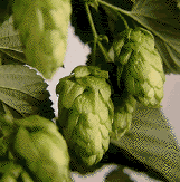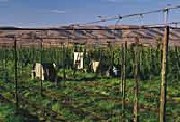Hops are the dried blossoms of the female hop plant (Humulus lupulus) which is native to many northern temperate areas. The hop varieties that we use are grown mainly in the Yakima Valley of Washington, the Willamette Valley of Oregon, and regions of Idaho and British Columbia. We also use varieties of specialty hops imported from England, Germany and Slovenia.
John I. Haas, Inc. Yakima Chief, Inc. S. S. Steiner, Inc
Hop additions are made at certain points during the boil in varied proportions. It is the bitter acids and resins of the hops, contained in the leafy petals, which impart the characteristic bitter flavour and hoppy aroma to beer. These are extracted during the boil. Aside from flavour improvement, the presence of bitter resins in wort adds greatly to its biological and colloidal stability.
A certain proportion of the fine flavours attributed to the essential oils of hops is lost during boiling, the oils being highly volatile and passing off in the steam. The usual procedure in making hop additions is to save the highest quality hops until near the end of the boil. This procedure ensures a finer hop flavour and aroma.
During the boil, the lauter tun is being emptied of its spent grains load. The spent grains from the brewery are highly regarded in the field of agriculture, especially as a source of feed for dairy cattle. It has a high protein and fat content; however, the vitamin content is low. The grains are sold in a wet condition, and quick consumption is mandatory. If it is not consumed, then lactic and butyric acid bacteria will begin to take over, producing strong, disagreeable odours which may put the cattle off this type of fodder.
Up to this point, we have a complete brew in the kettle in the form of a hopped sugar and protein solution called wort. The solution is sterile and a large amount of undesirable protein has precipitated out. The next step in the brewing procedure will be the removal of the protein matter and hop residue from the wort solution.
We then drop (known as "casting" or "striking") the brew into the hot wort tank, which is capable of holding an entire brew. The wort enters the side of the tank tangentially, to create a "vortex" effect. After dropping the brew from the kettle to this vessel, we give the brew a "rest". During this rest period, settling of undesirable protein matter and hop residue happens, gathering in a cone shaped pile in the centre of the tank; much like stirring a cup of tea leaves and removing the spoon. This waste material is known as "trub". The wort solution is still at a high temperature and it must be subjected to refrigeration before yeast can be added and fermentation can begin. Up till now, all protein precipitation is called the "hot break". From this point on, the strictest attention is devoted to maintaining sterile conditions.
The hot wort is pumped through a plate type cooler called a Paraflow cooler. The hot wort flows in one direction through the cooler while cold water flows in the opposite direction, the wort and water being separated by a series of plates. One section of the cooler is cooled by refrigerated glycol so that exact wort temperatures can be obtained throughout the entire year, since water temperatures are subject to seasonal variations.
The cooler performs other functions besides lowering the temperature of the wort. Sterile air is passed into the wort line coming from the cooler. Oxygen in solution is very necessary to the metabolism of the yeast at the start of the fermentation process. The rapid decrease in wort temperature facilitates further protein precipitation which is called the "cold break." The cooler is completely enclosed, the wort never being exposed to non-sterile conditions. It is easy to clean and sterilise with automated "clean-in-place" systems and is efficient from the standpoint of heat transfer, permitting the attainment of very exact temperatures and sterile wort in the fermenting tank. The water used during cooling is collected in holding tanks and is used as the brewing water in subsequent brews. The water gains a great deal of heat in the cooling process; thus making it possible to realise a considerable saving of steam, used to heat the brewing water to prepare it for the next "mash in."
During the cooling process, the yeast is "pitched", or added, in the fermenting tank, and after the cooling process is finished, fermentation commences. To reach this point in the brewing cycle, we have taken approximately eight hours.


